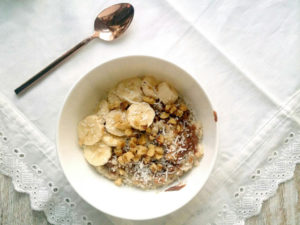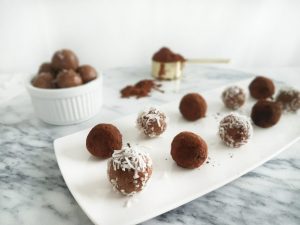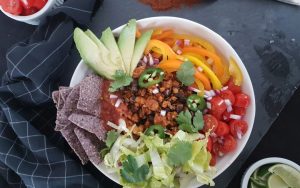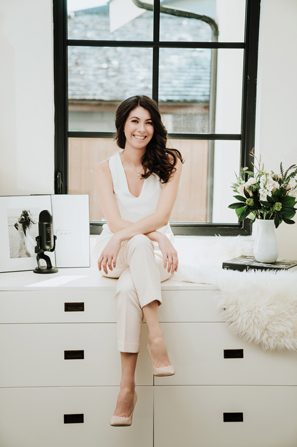Hello World!
As promised, I am so happy to finally share part 2 of my interview with Lindsay Pleskot, Registered Dietician! I was so lucky to get the opportunity to sit down with Lindsay. Nutrition is so important to your overall health; I always say – what you put in is what you get out. I made quite a few changes myself that align with what Lindsay has shared with us and really notice a difference in the way I feel physically, emotionally and mentally. I hope you are able to benefit from this knowledge as much as I have! Now let’s get to it…
.jpg) RB: How can someone maintain that healthy lifestyle they have worked so hard to attain while on their honeymoon or vacation?
RB: How can someone maintain that healthy lifestyle they have worked so hard to attain while on their honeymoon or vacation?
LP: If you’re not crash dieting before your wedding and you’ve developed some healthy eating habits as a lifestyle it’s not going to be as if you’re just waiting for your wedding day to be over so that you can binge on everything in sight.

Chocolate Peanut Butter Oatmeal with Coconut, Walnuts and Bananas
I just got married last year, and we had our honeymoon in Europe for 5 weeks and for me food is such a big part of travel! So you definitely want to be able to enjoy it. But this doesn’t mean that you have to eat everything in sight to the point of feeling sick. Eating mindfully is a great strategy to really enjoy the food without overdoing it.
Another tip I give to my clients when they’re traveling is start the day off right – breakfast is often an easier meal to prepare when you’re away. If you do have a small fridge, yogurt is a great choice. Add some fresh fruit, nuts and seeds or oats and you have a great breakfast bowl.
Even if you don’t have a fridge in your room, you can often pack stuff with you, for example, oats (recipe here) or nut butter to spread on some toast and have with fruit! If you can start your day with a good healthy balanced breakfast, it’s going to get your blood sugars balanced from the get-go, which can really help with cravings and appetite regulation later on in the day.
Packing snacks to have with you during the day is also a good idea, as it’s easy to get caught up doing something and forget to stop to eat; whether it be spending the day at the beach or walking around all day. It can be easy to go really long periods without eating and that’s when you’re prone to having those really intense cravings.
.jpg) Depending on how long you’re away for and how many meals you plan to eat out, this may impact how often you choose to just go for what you feel like versus consciously making more nutritious choices. A good option for a lighter meal is to go for an entree with a light protein like chicken or fish and opt for extra veggies on the side instead of the rice or potatoes. If you really want a pasta dish or pizza, you can split it with your wife or husband and then get a big green salad on the side.
Depending on how long you’re away for and how many meals you plan to eat out, this may impact how often you choose to just go for what you feel like versus consciously making more nutritious choices. A good option for a lighter meal is to go for an entree with a light protein like chicken or fish and opt for extra veggies on the side instead of the rice or potatoes. If you really want a pasta dish or pizza, you can split it with your wife or husband and then get a big green salad on the side.
RB: What types of food(s) should be avoided?
LP: There are definitely food you want to eat most of the time and others less regularly, but I really don’t believe that there are any foods that are absolutely, 100% off the table.
In general, refined foods that are really processed, have a million ingredients on the label, or include really refined sugars are the ones you might want to save as more of a treat. If you base your diet around these foods, you’ll be more likely to overeat as they don’t have the filling fiber or nutrition packed vitamins and minerals of whole foods that really fuel your body.
That being said, my focus isn’t generally on calories; it’s more about the quality of the food and what it’s doing for you. If you are constantly eating nutrient-void calories you’re going to be a lot more likely to overeat and then they are also not providing you with the fiber, the vitamins, and minerals that are in whole foods.
Each step of processing strips some of the nutrients from the natural food; you’re going to feel hungrier sooner and you’re going to digest a lot more quickly when foods have been processed (essentially pre-digested for you). Refined sugars can also lead to more inflammation in your body which is a risk factor for chronic diseases like diabetes, heart disease, and cancer.
So I would say limiting refined sugar and refined or processed foods, including trans-fats is the way to go. That being said, there is always rooms for treats.
We actually don’t have a ton of trans-fat in our food system anymore because we have learned how bad they are for us. Trans-fats are for the most part man-made fats; unsaturated fats that have been processed to the point where they’re so dense and bonded that it’s really hard for your body to break them down, so they kind of just sit in there and build up, wreaking havoc on your system.
So looking on packages for the word “hydrogenated” is one clue that the food contains trans-fats, of if you see trans-fats actually listed on the label, I would say you do want to avoid those whenever possible.
RB: Are there any super-foods that you should be eating more of; each year there seems to be a new one!
LP: The thing with super-foods is that there actually isn’t regulated so it often gets used for marketing and can be really confusing to people. The nutritional definition of a super food is really any food that’s nutritionally dense, so lots of nutrients per calorie consumed.
I really consider any fruit or vegetable to be a super food- kale, cauliflower, blueberries are a few that have been getting a lot of hype lately, but so is an apple, swiss chard or eggplant. Nuts and seeds are also foods I’d consider super-foods. Or fatty fish; the darker flesh fish like salmon, trout or mackerel. They contain omega-3 fatty acids that are good for brain development, good for your skin, your heart- those would also make my list.
Long story short, there’s a huge variety of super-foods. Think whole foods, plant foods- and not just limited to some exotic berry or expensive specialty item.
RB: What are some examples of healthy snacks?

Salted Caramel Energy Balls
LP: Keeping it really simple; one of my favorite snacks is an apple and small piece of cheese. I find this combo so satisfying! I also really love hummus with whole grain crackers or veggies. You can also make different bean dips to mix it up a bit. I like to make an edamame dip, make my own hummus or black bean dip.
Energy balls are another favorite! There are so many different variations, but I’m really into these salted caramel energy balls right now. All you need is dates, cashews and almonds and then a touch of salt and vanilla extract. Just blend them up and roll them into balls and the texture is just like caramel. They’re delicious! You can find the recipe on my website if you want to try them out. (recipe here)
For those that are sweet inclined, these salted caramel energy balls are a great option, or you could do a smoothie or banana ice cream! I thought banana ice cream was going to be a total hack but it actually is really delicious! All you do is freeze bananas and then add a splash of whatever milk you want to use (not as much as you put into a smoothie; you want to keep it more firm) and then put it all into a food processor or Vitamix which will blend it well. It comes out like a soft serve consistency and it’s so delicious. You can add cinnamon, nutmeg or cocoa. I’ve also done it with mint and cacao nibs; which kind of reminds me of the chocolate chip mint ice cream I used to love as a kid.
I’ve also got a sweet potato brownie recipe on my blog where you substitute the flour base for yams or sweet potatoes. they’re a great option to indulge in a little bit of what you like and get some extra nutrient-dense ingredients in there while you’re at it!
RB: How many times a day should people eat?
LP: This can be different for different people, but I find for myself, I usually feel my best if I’m eating 3 meals and 2 snacks. I find for most of my clients this works pretty well too!
So definitely your 3 meals a day – breakfast, lunch, dinner, with a snack between breakfast and lunch and usually another between lunch and dinner. In the morning I’ll usually just grab a piece of fruit. It can often be a pretty long break between lunch and dinner, so something a bit more substantial is good here. Getting some fiber and protein in here will give you longer lasting energy- fruit or whole grains for fiber and nuts or nut butter, maybe a small piece of cheese – those options will provide the protein. So that apple and cheese combo I mentioned earlier, perfect for an afternoon snack!
So generally somewhere between four to six times per day works well for most people.
I find if I’m eating really regularly throughout the day I’m not usually that hungry after dinner. I tend to eat dinner a little bit later, but for people that eat dinner at like 5 and go to bed at 11 or 12, they might need a little something in the evening as well. It’s not always bad to eat at night; it really depends on the whole schedule of your day.
RB: What are your thoughts on vitamins and supplements?
LP: My take on supplements is that they’re meant to be just that- something to supplement, not replace a good diet. That being said, there are certain nutrients that are a little harder to get on a consistent basis. So a few to consider would be a multivitamin, Vitamin D and an Omega-3 supplement. Multivitamins can give just that extra reassurance to fill in the gaps, Vitamin D, especially living here in Vancouver, we don’t get sun all year round so I usually recommend about 1000 IU Vitamin D a day, and for Omega-3 supplement, 600-900mg EPA and DHA per day. Even for supplements, it’s always a good idea to just run this by your doctor or dietitian first to make sure there are no contraindications for you specifically.
Ultimately, I would say focus on your diet first and see how you can get those nutrients out of the food you’re eating.
Our bodies are made to digest and absorb nutrients from a whole food form. They’re not really made to take a really concentrated, isolated form of something, we can really only take so much at a time.
There are also different vitamins and nutrients that work together to increase or help absorption. Iron and vitamin C, for example, vitamin C promotes the absorption of plant based iron so when you eat a whole food you’re going to get a combination of multiple nutrients that may actually be helping your body to it’s thing!
But again, it’s hard to get everything we need everyday so supplements can come into play and of course there are certain cases where they may actually be necessary. If you have a diagnosed deficiency or a medical condition that inhibits proper absorption, you may be prescribed specific supplements of higher doses to treat the issue.
RB: What are the best beverage options?
LP: Water is always a great option. To make it a bit more interesting, try infusing water or ice cubes with herbs and fruit.
I love mint and cucumber or even pineapple or grapefruit; they add tons of flavor and some extra nutrients too!
Matcha green tea is another favorite. Matcha differs from traditional green tea in that you are actually grinding up and consuming the tea leaf rather than just steeping it. Great for some extra antioxidants and caffeine kick.
Unsweetened herbal teas are another great option; you can either drink them hot or cool them in the fridge for a refreshing summer drink.
Kombucha is also a good choice every once in awhile. There is some sugar added in the process to actually ferment and create Kombucha. But a lot of that sugar is actually eaten up by the bacteria that is used to ferment the drink. It sounds kind of gross but this process ends up giving you a nice fizzy drink with probiotic benefits and a lower sugar content.

Lindsay’s Best Ever DIY Pumpkin Spice Latte
RB: What are good alternatives for those needing caffeine?
LP: I don’t consider coffee to be a bad thing to drink. I was actually just reading something this morning from a study that was talking about how coffee can actually decrease the risk of certain cancers. Of course like anything else, it can affect different people differently but two to three 8oz cups a day is generally considered safe if you’re not affected in other ways (anxiety, jitteriness or sleep disruption). I really like matcha as well for a nice mellow caffeine kick.
RB: How much water exactly should we be drinking daily – is it based on a person’s weight?
LP: That also depends person to person; how active you are, your height and weight. The best way to actually gauge how much liquid you need is by the color of your pee. Generally you want your pee to be a really light hay-like, pale yellow color. The more concentrated it is, the more dehydrated you are.
But you don’t need to be having completely clear pee, if that’s the case, you are probably just peeing out what you’re drinking and that can just be more of a nuisance than anything else.
Six to eight cups is sort of a good marker, but it doesn’t have to just be water. You can get water or fluids from fruit, soups, smoothies or tea as well.
RB: Living in Vancouver, we are blessed to be surrounded by an abundance of amazing restaurants, which are your favorite that offer healthy menu options?
LP: I really love Field and Social. I’m working with them right now on developing a new bowl for their menu. They have amazing salads; they are primarily a salad bar but they’ve got some really great hearty options. I love that they work with a lot of local businesses. They have a Tempeh that they source from Tempea Foods in North Vancouver and they source their grains from GRAIN, another local company.I like what they’re about and their food is amazing.
I also really like Heirloom on South Granville. It is delicious; their brunch is amazing!
Nourish Cafe is another one I really like, out near UBC.
Buddha-Full is another one I love; they’re in North Vancouver. I think they might have actually just opened up a second location. They have amazing smoothies, sandwiches, and paninis.
RB: What are your go-to recipes for breakfast, lunch and dinner?
LP: For breakfast I find I need a good source of protein or I tend to get hungry pretty quick. So I love any kind of eggs; hard boiled eggs, poached eggs, scrambled eggs with veggies. Avocado toast I also really love; just toast with mashed avocado and then whatever kind of topping you want, like cottage cheese, eggs or nuts. Oatmeal is another go-to but I generally go for oatmeal more in the winter months when I want something warmer, so good with some nut butter stirred in and topped off with fruit!

Fiesta Tempeh Taco Bowls
For lunch, I usually go with leftovers; whatever is left from dinner the night before. Or a big salad or grain bowl with whatever protein I have leftover. I’m a huge fan of batch cooking and meal prep to make life easier throughout the week.
Dinner can be anything from stir-fries to tacos (recipe here), barbecue or I do a lot of one bowl meals. I love pretty much all types of cuisine so it could be anything from sushi, curry or Mediterranean food- that combo of lemon, olive oil, feta, fresh veggies- that is definitely one of my favorite flavor profiles.
RB: What appliances/tools can you not live without?
LP: I’m obsessed with my microplane; it’s like a zester. Traditionally, they’re for zesting lemons or citrus, but can be used for so much more. I also use mine for parmesan cheese or even garlic and Ginger; it makes it super quick and easy to add tons of flavor to a dish.
I also love my Vitamix – we got it as a gift for our wedding and it has quickly become a staple. You can do everything with a Vitamix!
RB: Do you offer any coaching services?
LP: I have a couple of different packages.
I do offer one time consultations but generally I find most people are coming in wanting to make significant and lasting changes, which does take a bit more than a one time meeting. I want to get to know them and put together a plan and education that will suit them and work for their lifestyle.
All of my packages include my meal plan program, the 3-2-1 Method. It’s a 4-week meal plan that has lots of different options for people to modify to their taste. I find when people have the tools to get started right away and have something to follow then it also gives us more opportunity to focus on the other things that are impacting their eating; whether there’s any emotional eating or just habits that are really hard to break, we can really work on those.
I also do work with couples and families. This can be anything from learning simple recipes, how to cook, how to meal prep, education on food, or putting together a comprehensive plan to get them from A to B.
There’s the kick-start package which is an initial assessment where we go through all of their history, their goals, what’s working for them, what isn’t working, and then we put a personalized plan together for them. They also get a meal plan and then there’s one follow up to see how everything’s going and whether we need to adjust or add anything to make sure they’re set to go.
The most popular package is my 3 month. It’s an initial, the meal plan, and then 4 follow-ups. This allows us a bit more of an opportunity to dig a little deeper and make sure those changes are going to stick and it really provide that lifestyle change they’re after.
The 6-month package is similar; it’s an initial, the meal plan, and 7 follow ups. This package is great if there are some deeper rooted food issues or habits. Maybe they’ve struggled a lot throughout the years with dieting, body image, emotional eating, or just habits that are really hard to break. So it’s to be there to support them, and again make sure that any barriers or challenges that come up we have a plan in place to offset that and make sure that they’re on a good path going forwards.
RB: Tell us about your blog, what type of information do you share with your readers?
LP: It’s changed a little bit over the years but it’s primarily recipes and tips for simplifying nutrition. My focus with my blog and with my coaching services is really to help people cut through the confusion of the mixed messages and save time with simple but delicious recipes so that food really can be an enjoyable part of their life. My recipes are designed to be easy enough for a novice cook but still inspiring to the busy foodie. I also dabble a little bit in lifestyle stuff with a bit of travel and fashion.
RB: Are there any blogs that you love to follow?
LP: Instagram is probably the main place that I go for inspiration; I can get sucked into that for hours! I really like Fraiche Nutrition; she’s also a dietitian and lives here in BC. She has great recipes and awesome photography. Nutrition stripped is another one of my faves.
Find out more about Lindsay’s services, meal plans, and recipes at lindsaypleskot.com and make sure to follow her on Instagram (@lindsaypleskotrd)
Just in case you missed this in part 1, get to know Lindsay personally in the below video! See her answers to our random questions. And as a bonus, she’s going to show us how to quickly make a delicious healthy breakfast!
No Title
No Description
Thank you again to Lindsay for sharing her knowledge with us! It was a pleasure getting to know you as well!


